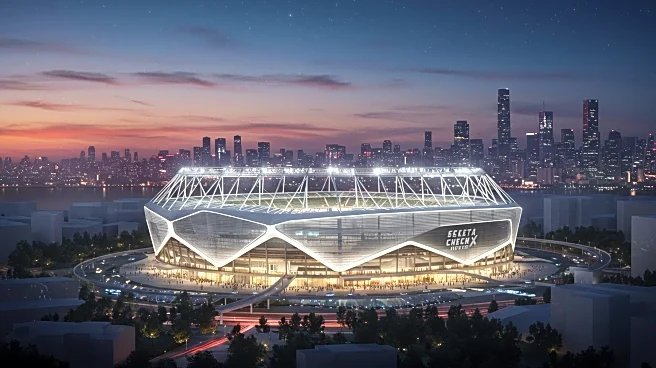What's Happening?
Cherwell District Council has given the green light to Oxford United Football Club's plans for the UK's first all-electric football stadium. The new stadium, with a capacity of 16,000, will be located on a five-hectare site known as the Triangle, situated between Oxford Parkway station and Kidlington roundabout. The site was chosen after evaluating over 60 alternatives, meeting operational, transport, and environmental criteria without posing flood or heritage risks. Designed by AFL Architects, the stadium will feature a steeply raked bowl enclosed on all sides, with the tallest stands on the west and north. The venue will operate entirely on renewable energy, utilizing photovoltaic panels, an air-source heat pump, and energy-efficient building materials, aiming to reduce CO₂ emissions by 80% compared to a gas-fired equivalent. The project also promises a 20% net gain in biodiversity through new tree planting and other ecological enhancements.
Why It's Important?
The approval of Oxford United's all-electric stadium is significant for several reasons. It represents a major step forward in sustainable sports infrastructure, aligning with broader climate strategies. The stadium's construction is expected to unlock over £130 million in local economic investment and create substantial employment opportunities during both construction and operation phases. Additionally, the development will enhance community amenities, offering facilities such as a conference center, health services, and hospitality spaces that will operate on non-match days. The project also supports sustainable travel, with plans for nearly 450 cycle spaces and dedicated fan shuttles, potentially making 90% of match-day journeys sustainable.
What's Next?
Following the council's approval, Oxford United will proceed with the construction of the stadium, which is expected to secure the club's long-term future. The development will also involve new transport infrastructure to encourage sustainable travel, including enhanced bus and rail services. The stadium's design and landscaping will aim to mitigate visual impact and maintain openness in the Green Belt area. The project is poised to deliver significant community benefits and align with local transport and climate strategies.
Beyond the Headlines
The decision to approve the stadium despite its location in the Green Belt highlights the council's recognition of 'very special circumstances,' including the club's need for a permanent home and the sustainable design's economic and community benefits. This move may set a precedent for future developments in protected areas, balancing environmental concerns with economic and social gains.











